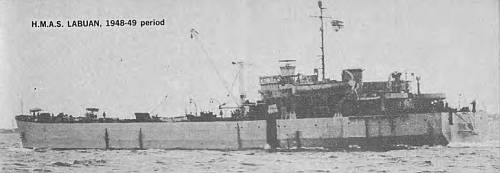- Author
- Vickridge, G.L.W., Lieutenant, RANR
- Subjects
- RAN operations
- Tags
-
- RAN Ships
- HMAS Wyatt Earp, HMAS Wongala, HMAS Albatross, HMA LST 3501, HMAS Labuan I, HMAS Moresby I, HMAS Whyalla I, HMAS Shepparton I, HMAS Australia II
- Publication
- January 1972 edition of the Naval Historical Review (all rights reserved)
Refitted and adapted at Garden Island Dockyard for Antarctic conditions, the Navy landing ship had all the accoutrements of war removed and was painted yellow from stem to stern; the bridge housing was fully enclosed to provide all-weather protection. Preparations by the RAN Victualling Stores included furnishing the two island parties each with food stocks for fifteen months.
Prior to the departure of LST 3501 from Melbourne on 17th November 1947 the Minister for the Navy, Mr. Riordan, inspected the ship and a naval guard of honour, and was introduced to members of the Heard Island expeditions, the first group to be taken south. In a farewell address on behalf of the Commonwealth Government, the Minister said that it was the first time that any country had planned three separate expeditions to Antarctic regions.
Commanding Officer of the landing ship was Lieutenant Commander George M. Dixon, RANVR, who had seen service during landing operations in the Mediterranean and at Tristan da Cunha, and was one of the most experienced officers in this type of operation in the RAN.
After leaving Fremantle the LST encountered a heavy gale during which deck cargo broke loose, mess-decks flooded and only fifty miles progress was made in twenty four hours. Further difficulties arose when the main oil feed pump stopped and for over an hour, the flat-bottomed vessel was left wallowing lifeless and beam on to the heavy swell.
LST 3501 arrived at Heard Island on 11th December and Lieutenant Commander Dixon, not unmindful of the hazardous nature of the landing to be undertaken, informed all aboard that; ‘While it is calm, landing operations will be carried out unceasingly so long as there is sufficient light, by either sun or moon.’ It was a race against the elements.
In Melbourne it had seemed unlikely that the LST would be able to beach but after a week of several near disastrous attempts using the two LCVPs (Landing Craft, Vehicles and Personnel), a work-boat and a dinghy, Lieutenant Commander Dixon beached 3501. While manoeuvring her off the beach after the first of three landings, the LST went aground for an anxious three hours.
On 21st December a storm, so severe that the pen ran off a barograph set up ashore, hit the ship and there were further anxious hours while the flat-bottomed vessel clawed its way off a lee shore in a 120 knot gale.
LST 3501 finally sailed on 28th December for Kerguelen Island and there heard the news of Wyatt Earp turning back. Dixon was instructed to return to Heard Island and take off Group Captain Campbell who had sailed with the expedition; it was apparent that there was not enough of the season left for Wyatt Earp to call at Heard Island in March or April as originally planned.
On return to Melbourne it was necessary for the LST to be docked for inspection and overhaul before sailing with the Macquarie Island party on 28th February 1948. Wyatt Earp met up with 3501 while the latter was at Macquarie Island landing the expedition under less hazardous conditions than at Heard Island. Dixon returned to Melbourne with seals and penguins for the Melbourne Zoo.
Because of the lack of a suitable vessel to replace Wyatt Earp, future expeditions in which the RAN was involved were confined to the annual relief of the two Island parties. On 2nd November 1948, 3501 was renamed and it was as HMAS Labuan that the landing ship sailed south in 1949. On this and all subsequent occasions, Army DUKWs were used in the landing operations with great success. After relieving the first Heard Island party, a survey of the remaining two miles of uncharted coastline was completed.
In July 1950, HMAS Australia made a mid-winter dash south to Heard Island to evacuate the expedition’s medical officer who was critically ill, and land two reliefs.

The major problems with early ANARE expeditions were the finding of a suitable ship, and landing supplies. Labuan, which had done excellent work in carrying the pioneer parties, continued to carry out the annual relief of the Heard Island and Macquarie Island stations under the direction of the RAN. It was obvious, however, that a ship of her kind could not continue to indefinitely batter her way down each year on the 3,500 mile voyage and it was not altogether surprising that in 1951 she finally became unseaworthy after a particularly rough passage to Heard Island.




